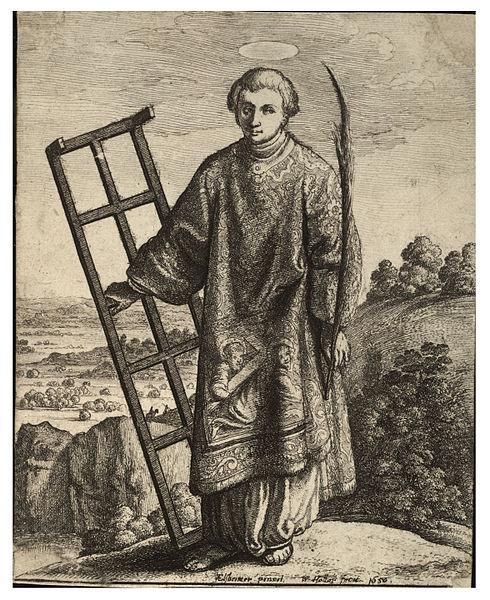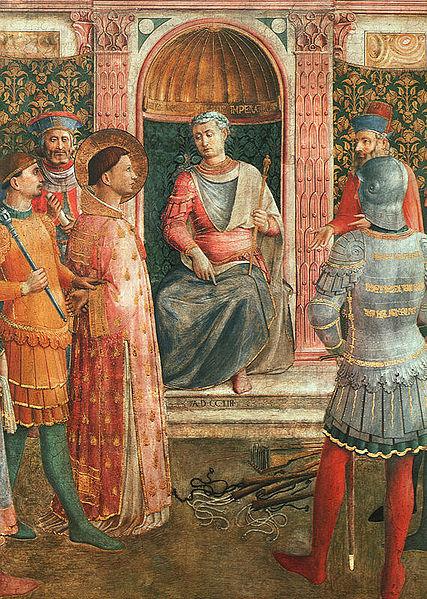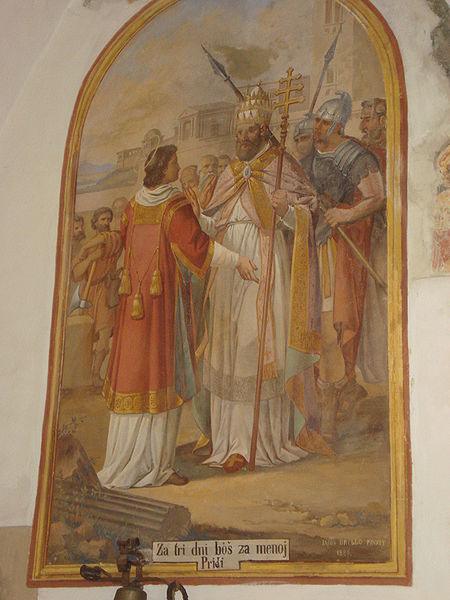St. Lawrence
Martyr; died 10 August, 258.
St. Lawrence, one of the deacons of the Roman Church, was one of the victims of the persecution of Valerian in 258, like Pope Sixtus II and many other members of the Roman clergy. At the beginning of the month of August, 258, the emperor issued an edict, commanding that all bishops, priests, and deacons should immediately be put to death (“episcopi et presbyteriet diacones incontinenti animadvertantur” — Cyprian, Epist. lxxx, 1). This imperial command was immediately carried out in Rome. On 6 August Pope Sixtus II was apprehended in one of the catacombs, and executed forthwith (“Xistum in cimiterio animadversum sciatis VIII id. Augusti et cum eo diacones quattuor.” Cyprian, ep. lxxx, 1). Two other deacons, Felicissimus and Agapitus, were put to death the same day. In the Roman Calendar of feasts of the fourth century their feast day is on the same date. Four days later, on the 10th of August of that same year, Lawrence, the last of the seven deacons, also suffered a martyr’s death. The anniversary of this holy martyr falls on that day, according to the Almanac of Philocalus for the year 354, the inventory of which contains the principal feasts of the Roman martyrs of the middle of the fourth century; it also mentions the street where his grave is to be found, the Via Tiburtina (“III id. Aug. Laurentii in Tibertina”; Ruinart, “Acta sincera”, Ratisbon, 1859, 632). The itineraries of the graves of the Roman martyrs, as given in the seventh century, mention the burial-place of this celebrated martyr in the Catacomb of Cyriaca in agro Verano (De Rossi, “Roma Sott.”, I, 178).
Since the fourth century St. Lawrence has been one of the most honoured martyrs of the Roman Church. Constantine the Great was the first to erect a little oratory over his burial-place, which was enlarged and beautified by Pope Pelagius II (579-90). Pope Pope Sixtus III (432-40) built a large basilica with three naves, the apse leaning against the older church, on the summit of the hill where he was buried. In the thirteenth century Honorius III made the two buildings into one, and so the basilica of San Lorenzo remains to this day. Pope St. Damasus (366-84) wrote a panegyric in verse, which was engraved in marble and placed over his tomb. Two contemporaries of the last-named pope, St. Ambrose of Milan and the poet Prudentius, give particular details about St. Lawrence’s death. Ambrose relates (De officiis min. xxviii) that when St. Lawrence was asked for the treasures of the Church he brought forward the poor, among whom he had divided the treasure, in place of alms; also that when Pope Sixtus II was led away to his death he comforted Lawrence, who wished to share his martyrdom, by saying that he would follow him in three days. The saintly Bishop of Milan also states that St. Lawrence was burned to death on a gird-iron (De offic., xli). In like manner, but with more poetical detail, Prudentius describes the martyrdom of the Roman deacon in his hymn on St. Lawrence (“Peristephanon”, Hymnus II).

The grill of St. Lawrence and his mortal remains, along with the body of St. Stephen the proto-martyr at the Basilicia of St. Lawrence-Outside-the-Walls.
However, in spite of this criticism of the later accounts of the martyrdom, there can be no question that St. Lawrence was a real historical personage, nor any doubt as to the martyrdom of that venerated Roman deacon, the place of its occurrence, and the date of his burial.
Pope Damasus built a basilica in Rome which he dedicated to St. Lawrence; this is the church now known as that of San Lorenzo in Damaso. The church of San Lorenzo in Lucina, also dedicated to this saint, still exists. The feast day of St. Lawrence is kept on 10 August.
(cfr. Catholic Encyclopedia)
____________________________
St Lawrence is especially honoured in the city of Rome, where he is one of the city’s patrons. There are several churches in Rome dedicated to him, including San Lorenzo in Panisperna, traditionally identified as the place of his execution. He is invoked by librarians, archivists, cooks, and tanners as their patron. His celebration on 10 August has the rank of feast throughout the entire Catholic world. On this day, the reliquary containing his burnt head is displayed in the Vatican for veneration.
The Escorial Palace, situated at the foot of Mt. Abantos in the Sierra de Guadarrama, was built by King Philip II of Spain to commemorate the victory of Spanish forces over those of King Henry II of France at the Battle of St Quentin, which took place on the feast of St Lawrence on 10 August 1557. To honour the martyr, the entire floor plan of this imposing edifice was laid out in the form of a gridiron, the means by which St Lawrence was martyred.
French explorer Jacques Cartier gave the name of Saint Lawrence to the widest river estuary in the world. At the mouth of this river is the large Gulf of Saint Lawrence, surrounded by all the Canadian Maritime provinces. Closer to the source of this river are the Laurentian mountains (north of the city of Montreal), the major Montreal borough of Saint-Laurent (borough), as well as the famed Saint Lawrence Boulevard that spans the full 11.25 km width of the island of Montreal. Further upstream, on the south side of the river near its source at Lake Ontario, is St. Lawrence County, New York.













